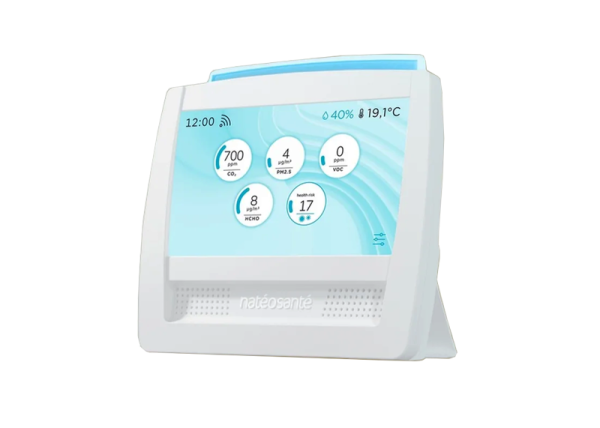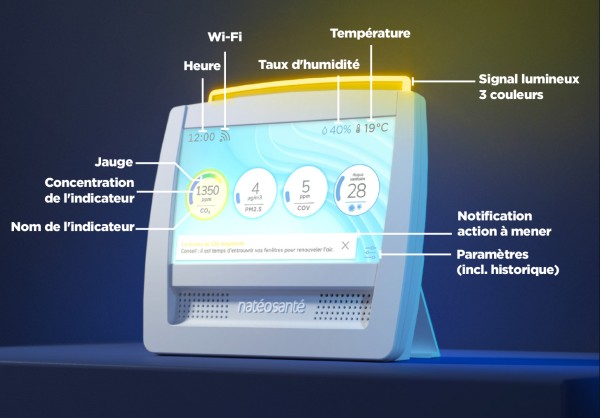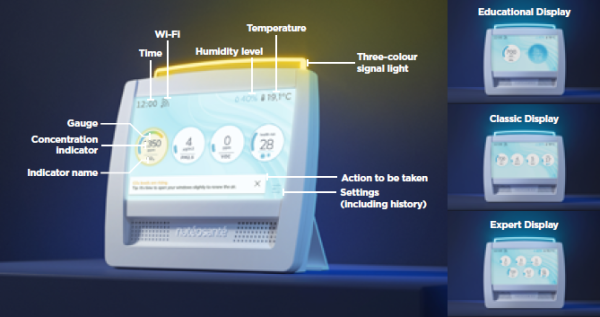Air Coach - Monitor indoor air quality in real-time
Designing the clinical and diagnostic areas of the vet clinic
Air Coach - Monitor indoor air quality in real-time
Measurement, display and analyze of your clinic air quality New!
With Air Coach, you’ll know when it's time to take action!
Air Coach is the first monitor which analyses IAQ information for you and advises on which actions to take: the effectiveness of which you can measure immediately. Thanks to Air Coach, you can react to your indoor air quality before it deteriorates.
CO2 indicator: assess the containment rate
- The CO2 sensor (NDIR technology) and Air Coach's signal light alerts you when the carbon dioxide level deteriorates so that when it's time to ventilate, Air Coach will tell you the appropriate amount of time to do so.
- Set the ventilation threshold according to your environment and/or business.
Monitor indoor air quality in real-time
- High precision sensors for transparent measurement (depending on the model):
- Carbon dioxide (CO₂)
- Volatile Organic Compounds (VOCs)
- Fine particles (PM10, PM2.5, PM1)
- Formaldehyde
- Gauges indicating the concentration of each pollutant in the air and displaying the general status of indoor air quality.
- History to view one week's IAQ data and download the previous month's data.
- Three display modes: educational, classic, expert, for a clear informational overview according to your requirements.
Advice on how to do the right action at the right time
- Anticipation of air quality degradation: Air Coach performs trend analysis to inform you in advance that a threshold will be reached if no action is taken. Thanks to its three-colour signal light, everyone knows when it’s time to act wherever they are in the room.
- Air Coach guides you: with its many tips and recommendations, it helps you maintain good IAQ on a daily basis.
A Health Risk Index to protect effectively
- A true innovation, this index takes into account many environmental parameters of the room to provide you with reliable information about your level of exposure to health risk(s).
- Ranging from 1 to 100, it gives you an indication of the risk of airborne transmission of winter respiratory viruses, such as Covid, and other micro-organisms.
Challenges of air quality in the veterinary environment
- Protect the animals
By reducing nosocomial and contagious airborne diseases
- Protect the verinary team
By reducing exposure to harmful chemicals and possible infectious risks
- Improve reception and working conditions
By purifying the air and destroying undesirable odors (animals, urine, faeces, chemicals, etc.)
Air quality in veterinary clinics is often an underestimated aspect, but it plays an essential role in the health and well-being of animals, staff and visitors. A wide range of chemical and biological pollutants are emitted into the air as a result of the various activities involved in animal care, anesthesia, cleaning and surgery. If these pollutants are not properly controlled, they can cause serious health problems and post-operative complications, affecting the clinic's overall performance.
Health risks associated with poor air quality
Chemical risks
- Gaseous anesthesia:
- Isoflurane: toxic for reproduction
- Halothane: hepatite MP N°89
- Nitrous oxide: neurological and haematological toxicity
- Surgical procedures and electrocautery fumes: exposure to harmful particles, viruses and toxins
- Disinfection and cleaning products: formalin (formaldehyde): carcinogenic effect for humans - decree of 13/07/2006
- Healthcare products: antibiotics, tranquilizers, hormones, anti-inflammatories, dewormers, anti-cancer drugs, etc.
- Radiology and imaging procedures on older equipment: hydroquinone in developers (carcinogenic effect)
- Laboratory activities: solvents and fixing agents containing formaldehyde (carcinogenic).
These chemical risks can lead to:
- Worsening of respiratory conditions: feline asthma and chronic bronchitis
- Post-operative recovery: longer, with increased risk of complications
Allergic risks
- Chemicals: aldehydes, quaternary ammoniums, chlorhexidine, iodine derivatives: allergic dermatitis
- Animal hair, dander, saliva: rhinitis, contact eczema, asthma
Biological riks
- Risk of exposure to contagious and/or nosocomial diseases: Staphylococcus aureus, Enterobacteriaceae, canine adenovirus, feline calicivirus, etc. (nosocomial transmission rate estimated at 5-8% in French veterinary clinics).
Air Coach Pro Formaldehyde
- 3 display modes:
- Educational: Temperature, Humidity, CO2 , Overall IAQ
- Classic: Temperature, Humidity, CO2 , VOCs, PM2.5, Health Risk Index (HRI)
- Expert: Temperature, Humidity, CO2 , VOCs, PM1, PM2.5, PM10, Formaldehyde, Health Risk Index (HRI)
- Measuring range:
- CO2 : 0 – 10 000 ppm - Accuracy : +/- 30 ppm + 3% of the measured value
- COV : 0 - 30 ppm (ethanol equivalent)
- PM1, 2.5 & 10 : 0 - 2 000 µg/m3 - Accuracy: +/- 10 % of measured value
- Formaldehyde (HCHO) : 0 – 1 250 µg/m3 - Accuracy: +/- 25 µg/m3 or +/- 20% of the measured value
- General IAQ status: Educational gauge
- Concentration per pollutant: Individual gauge
- Action indicator: Three colour signal light + advisory notifications
- Data history: Consultation sur l'appareil (1 semaine), téléchargement via micro SD (1 mois)
- Standby mode
- 7'' display
- Dimensions hxlxp : 17 x 18.5 x 3.5 cm
- Weight: 0.5 kg
- Power supply: 110-220V / 50-60 Hz
- Min/max power input (W) : 1.8 - 3.9
- Wall mount and stand included












